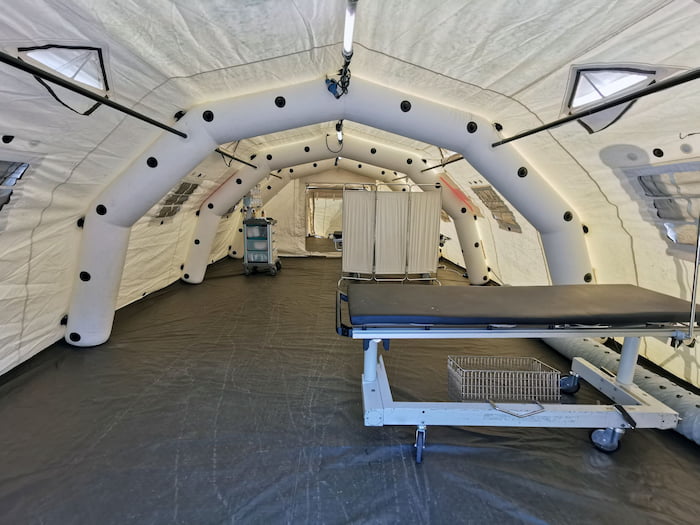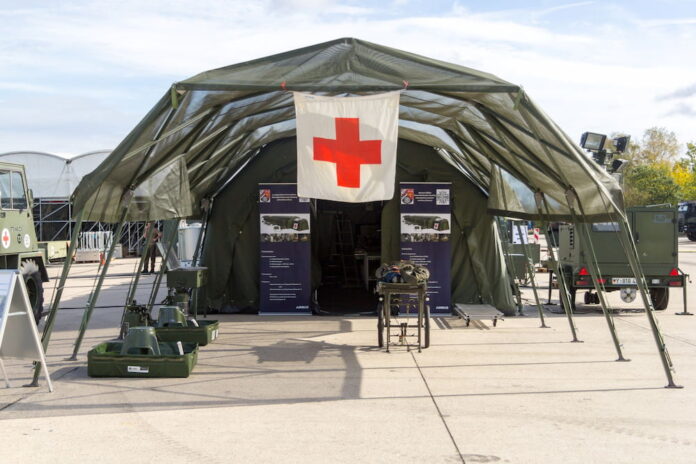Global warming and other environmental issues have recently exposed us to more frequent, violent, and highly damaging calamities.
The global Emergency Events Database (EM-DAT) recorded 432 disastrous events in 2021, a relatively higher figure than the 357 average between 2001 to 2020.
The first four months of this year were neither easy nor smooth sailing. There were violent cyclones in New Zealand, flooding in Brazil, tornadoes in the United States, and the Turkey-Syria earthquake, which claimed the lives of more than 50,000 people.
Major disasters put a heavy strain on resources, and most governments (especially in developing countries) are often unable to meet the compounding needs of their citizens. In such cases, military field hospitals are usually built to supplement, if not temporarily replace, struggling or non-functioning healthcare facilities.
Since natural disasters are inevitable, the government and private sectors must work together to adopt a proactive and flexible approach to calamity response. Field hospitals are the latest in that long line of solutions and may play a bigger role in the future.
Here’s how to prepare and set up mobile field hospitals for calamities.
1- Coordination Is Key
Host countries often need help to address large-scale disasters and would welcome any assistance. However, before setting up a mobile field hospital, it’s imperative for aid organizations, whether government or private-sector-led, to coordinate with authorities and other groups on the ground.
Organizations must likewise conduct a rapid assessment to determine the best location and offer other assistance modes to vulnerable, unserved, or underserved populations. Doing so ensures equitable healthcare access even during calamities. Studying the situation and acting according to needs allows seamless operations between and among humanitarian groups, benefitting the disaster victims.
2- Setting Up The Mobile Field Hospital
Mobile hospitals range from a few small tents to huge portable medical units within or near a disaster zone. The site must be safe from the next calamity or attack, as aid groups must put a premium on the safety and lives of their staff.
Here are some key considerations:
Choosing a location
While it’s important to be at the heart of the calamity area, you must consider factors like logistics, access to resources, security, and safety. Striking a good balance between these elements is necessary for deciding where to set up your operations.
Quick deployment
Ideally, the facility must be built within a day or two following an internal rapid assessment activity—where the medical team can identify priority healthcare needs. Field hospitals are classified based on their proximity, the number of medical staff, available medical equipment and supplies, and the services they provide.
Basic facilities required
At the minimum, mobile field hospitals must have access to a water source. Power supplies, like generators, vehicles, and telecommunications equipment, are likewise necessary. So are local volunteers, who may be medical professionals or individuals with a non-medical background.
Keeping these considerations in mind ensures the safe, efficient setup of field hospitals in crisis situations.

3- Building Your Team
The success of any healthcare facility largely depends on the medical team. Field hospitals are no exception.
Mobile field hospital staff should be skilled and experienced enough to work in high-pressure and challenging situations. Disaster victims undergo severe mental and physical trauma, and healthcare workers need special training to handle and interact with them efficiently.
Nurses must be skilled at triaging or identifying patients with urgent healthcare needs. In addition, employing reliable local staff may be necessary to work around communication and cultural gaps.
4- Equipping The Field Hospital
In most cases, field hospitals become the first point of contact for the sick and injured. Basic medical and pharmaceutical items must be available, including devices for taking and monitoring vital signs.
Equipment needs will depend on the procedures your facility is authorized to perform, including pain and wound management, minor or major surgeries, etc.
Regardless of the types of health care services to be performed, field hospitals must include a shelter for the staff and at least one each for patients’ isolation, waiting, and recovery areas. Such spaces ensure that patients don’t get worse while waiting for their turn or that they can recuperate from injuries and trauma as soon as possible.
5- Ensure Mobility, Safety, And Communication
Proper access to logistics and communication are at the front and center of every mobile field hospital operation.
Such a facility must have easy and swift access to supplies, personnel, and patients to ensure smooth operations. Any obstacle to mobility can hamper their operations and deprive patients of life-saving services.
Similarly, with communication, the mobile field team can perform basic operations and arrange supply pick-ups, patient transfers, or medical evacuations. These are priority factors when choosing the right field hospital location.
Personnel safety is also paramount in any disaster response. Besides ensuring that the field hospital is located outside hazardous areas, deploying security personnel nearby is best, especially in conflict zones.
The New Nexus Of Crisis Care
Disaster response must be quick yet tailored based on the priority needs of the affected population. The practices discussed above can be implemented to improve responses during emergencies without compromising the response team’s safety and security.
As such, mobile field hospitals must be versatile to meet the rapid changes in the field. A highly flexible yet scalable response can easily be set up and expanded as you improve your hospital operations internally, addressing the medical needs of disaster victims more efficiently.
Read Also
- The Future of Men’s Health: Why Telehealth Is Here to StayTelehealth isn’t just a pandemic trend that faded into the background. For Australian men, it has become one of the most practical, time-saving, and stress-free ways to manage everyday health — and it’s shaping the future of how we access care. Platforms like DOCTO, an Australian online doctor and specialist telehealth service, are leading the… Read more: The Future of Men’s Health: Why Telehealth Is Here to Stay
- Plastic Injection Molding Solutions: Precision, Efficiency, and Innovation Shaping Modern ManufacturingPlastic injection molding has become one of the most essential manufacturing processes across global industries. From medical devices and aerospace components to industrial equipment, electronics, and consumer goods, companies rely on molding solutions that deliver accuracy, consistency, and scalability. As demand grows for tighter tolerances, specialized materials, and more complex geometries, manufacturers increasingly partner with… Read more: Plastic Injection Molding Solutions: Precision, Efficiency, and Innovation Shaping Modern Manufacturing
- Automated Healthcare Software Solutions: How Intelligent Platforms Are Redefining Clinical, Administrative, and Operational ExcellenceThe healthcare industry is undergoing a seismic transformation. Rising patient volumes, value-based care models, staffing shortages, and complex regulatory demands have prompted organizations to look beyond traditional tools and embrace advanced software automation. As providers search for innovative partners capable of tailoring these sophisticated systems to real-world workflows, many turn to MCSI (Managed Care Systems,… Read more: Automated Healthcare Software Solutions: How Intelligent Platforms Are Redefining Clinical, Administrative, and Operational Excellence
- How to Build a Simple, Clean Skincare Routine ?You don’t need a complicated skincare routine. It doesn’t have to be something that requires twenty different products and confusing steps. Your routine works well with just a few high-quality clean ingredients. The beauty industry keeps pushing more products, but your skin actually needs less. You only need a simple approach to get better results… Read more: How to Build a Simple, Clean Skincare Routine ?
- How Preventive Dental Care Supports Overall HealthHave you ever wondered how a simple dental checkup could impact your entire body? Oral health is more than just a bright smile. Studies show that poor dental habits can contribute to serious health problems. Gum disease and tooth decay are linked to heart disease, diabetes, and infections. Yet, many people overlook preventive dental care.… Read more: How Preventive Dental Care Supports Overall Health
- Top 3 Online Dispensaries in Canada, And Why TLV Finest Budz Stands Above the RestThe growth of Canada’s legal cannabis market has made it easier than ever for customers to access high-quality products from the comfort of their homes. With so many online dispensaries available today, choosing the right one can feel overwhelming. Most customers look for trusted sources that provide quality, transparency, reliable delivery, and fair pricing. Among… Read more: Top 3 Online Dispensaries in Canada, And Why TLV Finest Budz Stands Above the Rest







